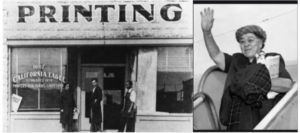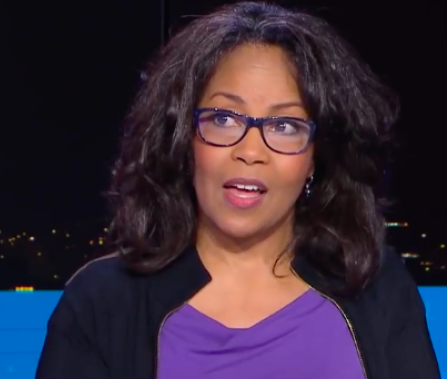Why Mrs. Charlotta Bass for VP? Her Agenda, not her Gender in 1952
(PARIS, France) It’s been 68 years since African American newspaper executive Charlotta Bass ran for U.S. vice president with a candidacy based on her merit and platform ideas. This hidden history occurred 20 years earlier than Rep. Shirley Chisholm’s run for U.S. president, as the first black woman candidate. Mrs. Bass accepted the nomination as neither Republican nor Democrat, but as a member of the newcomer Progressive Party.
« … I found that one political world [the Progressives] could provide a home big enough for Negro and white, for native and foreign-born, to live and work together for the same ends—as equals.»
~Charlotta Bass
 “Win or lose, we win by raising the issues,» said Mrs. Bass and her running mate, Vincent Hallinan, a crusading, anti-corruption attorney.
“Win or lose, we win by raising the issues,» said Mrs. Bass and her running mate, Vincent Hallinan, a crusading, anti-corruption attorney.
The Progressives had no illusions of victory, but the Hallinan-Bass ticket used its prominence to urge the passage of anti-lynching laws and the end of police brutality, unfair housing, and the death penalty. They also advocated job equality, civil rights, women’s business development, and women’s voting rights. In her memoir, Forty Years: Memoirs From the Pages of a Newspaper, the Los Angeles, California-based publisher writes:
«The platform for the Bass candidacy was characteristic of the long fight waged for the Negro people, for civil rights, and for the working people everywhere. My platform stressed world peace, world-wide neighborliness, jobs for all, civil liberties, and security. » (p. 173)
In the text below, she explains why she’s politically at home in the progressive camp.
The Progressives value her Political Agenda, over her Gender
Charlotta Bass’ political evolution (during the 1910s through to the ’60s) mirrors the movement within the black voting block. The Republican Party had been the party of choice for most of the newly-enfranchised black voters after the Civil War. But, Mrs. Bass, like others, dropped blind loyalty to the past and shifted her allegiance due to her policy concerns.
The Progressive Party « … promise[d] to increase federal regulation and protect the welfare of ordinary people » when it launched in 1912. The Progressive Party is typically called the Bull Moose Party because former U.S. President Teddy Roosevelt* was its first presidential candidate. FDR’s second vice president, Henry Wallace, is the party’s POTUS nominee in 1948. (Source: loc.gov)
The Progressive Party Platform of 1912 spells out its discontent with the political parties that existed at the time:
- The deliberate betrayal of its trust by the Republican party, the fatal incapacity of the Democratic party to deal with the new issues of the new time, have compelled the people to forge a new instrument of government through which to give effect to their will in laws and institutions.
- Unhampered by tradition, uncorrupted by power, undismayed by the magnitude of the task, the new party offers itself as the instrument of the people to sweep away old abuses, to build a new and nobler commonwealth.
At the time of the Bass candidacy–in 1952–voters had nine parties to choose from on the presidential ballot! Imagine that. See the results below. Tracking election results reveals that the splintering of voters from the dominant Republican Party did not automatically send them to the Democrats.
Voters expected choice at the polls, and they got it.
Routinely, during the early 20th century, there were 6 or more parties on the final presidential ballot. There had been 10 parties on the national ballot in the 1932 election, which Franklin D. Roosevelt won.
All this means the candidate at the top of the ticket could not afford to play identity politics and overlook the substance of a candidate. The presidential hopeful could not make a frivolous choice at VP. Not back then.
Enter Mrs. Bass.
« … I pledge myself and my sacred honor to aid in the task of bringing forth a new nation conceived in the hearts of the people, and really dedicated to the cause of freedom, liberty, and justice for all of mankind.» (from Forty Years, p.175)
Now in 2020, Democratic candidate Joe Biden vows to select a female running mate. “I commit that I will pick a woman to be Vice President. There are a number of women who are qualified to be president tomorrow,” announced Mr. Biden from the debate stage in mid-March.
Is Mr. Biden reducing a female candidate in these modern times to her gender instead of her agenda? That’s neither progressive nor is it in the Progressive tradition of the Hallinan-Bass partnership. Between the Democrats and the Republicans, which party is looking forward in this election?
The activist editor takes on Hollywood’s Birth
Charlotta Bass (1874- 1969) changed the newspaper’s name from The California Owl to The California Eagle, and expanded its coverage of issues affecting African Americans. She used the pages of her Los Angeles paper to call for a boycott of Birth of A Nation–the racially incendiary movie that D.W. Griffith shot in her L.A. community. Her activism is noted by historians as the first time a media organization pushed for community standards to be followed in a film. She managed the newspaper until 1951, one year before her run for VP.
*Mr. Roosevelt served as president from 1901 to 1909.
# # #
Paris, France-based Nita Wiggins is the author of Civil Rights Baby: My Story of Race, Sports, and Breaking Barriers in American Journalism. Because of the Covid-19 lockdown throughout France, Nita is training her executive clients and her journalism students online. Follow her @MsNitaWiggins and at nitawiggins.com.







